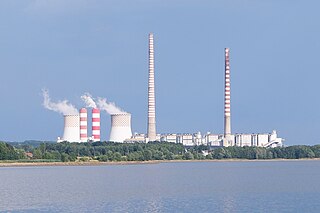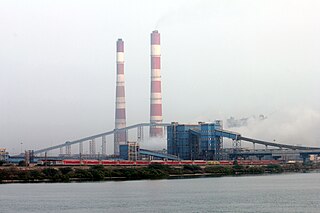
NLC India Limited (NLC) is a central public sector undertaking under the administrative control of the Ministry of Coal, Government of India. It annually produces about 30 million tonnes of lignite from opencast mines at Neyveli in the state of Tamil Nadu in southern India and at Barsingsar in Bikaner district of Rajasthan state. The lignite is used at pithead thermal power stations of 3640 MW installed capacity to produce electricity. Its joint venture has a 1000 MW thermal power station using coal. Lately, it has diversified into renewable energy production and installed 1404 MW solar power plant to produce electricity from photovoltaic (PV) cells and 51 MW electricity from windmills.

The Bełchatów Power Station is a coal-fired power station near Bełchatów, Poland. It is the largest thermal power station in Europe. The power station is owned and operated by PGE GiEK Oddział Elektrownia Bełchatów, a subsidiary of Polska Grupa Energetyczna.

The Maritsa Iztok Complex is the largest energy complex in South Eastern Europe. Maritsa Iztok 1 and 3 located entirely within Stara Zagora Province in south-central Bulgaria while Maritsa Iztok 2 is split with eastern neighboring Sliven Province. It consists of three lignite-fired thermal power stations. The complex is located in a large lignite coal basin, which includes several mines, enrichment plants, a briquette plant and its own railway system. The development of the thermal power and mining complex at Maritsa Iztok began in 1952, but the lignite deposits used to be known well in the mid-19th century. The Maritsa Iztok mines and power plants are interdependent as the only market for coal is the power plants, while the power plants have no other supplier of coal but the mines.

Rybnik Power Station is a hard coal-fired power station at Rybnik in Poland. The power station was built in the 1970s. It has installed power generation capacity of 1,775 MW. The average annual production of electricity amounts to 9 TWh. Rybnik Power Station has two 120-metre (390 ft) tall cooling towers and two large flue gas stacks, one with a height of 260 metres (850 ft) and another with a height of 300 metres (980 ft).

Raichur Thermal Power Station (RTPS) is a coal-fired electric power station located at Yadlapur D(Shaktinagar) in the Raichur district of the state of Karnataka, India. It is operated by the Karnataka Power Corporation Limited (KPCL) and was the first thermal power plant to be set up in the state. The power station was commissioned during various periods from 1985 and it accounts for about 70% of the total electricity generated in Karnataka.

Dunston Power Station refers to a pair of adjacent coal-fired power stations in the North East of England, now demolished. They were built on the south bank of the River Tyne, in the western outskirts of Dunston in Gateshead. The two stations were built on a site which is now occupied by the MetroCentre. The first power station built on the site was known as Dunston A Power Station, and the second, which gradually replaced it between 1933 and 1950, was known as Dunston B Power Station. The A Station was, in its time, one of the largest in the country, and as well as burning coal had early open cycle gas turbine units. The B Station was the first of a new power station design, and stood as a landmark on the Tyne for over 50 years. From the A Station's opening in 1910 until the B Station's demolition in 1986, they collectively operated from the early days of electricity generation in the United Kingdom, through the industry's nationalisation, and until a decade before its privatisation.

Little Barford Power Station is a gas-fired power station just north of the village of Little Barford in Bedfordshire, England. It lies just south of the A428 St Neots bypass and east of the Wyboston Leisure Park. The River Great Ouse runs alongside. It was formerly the site of two coal-fired power stations, now demolished. The station is operated by RWE.
Rotherham power station was a coal-fired power station sited close to the centre of Rotherham in South Yorkshire.
Parichha Thermal Power Station is located at Parichha in Jhansi district in the Indian state of Uttar Pradesh, about 25 km from Jhansi on the bank of Betwa river. The power plant is owned and operated by Uttar Pradesh Rajya Vidyut Utpadan Nigam which is a state enterprise.

Taylors Lane Power Station is situated in Willesden, north-west London. The first power station on the site, known as Willesden power station, was coal-fired and operated from 1904 to 1972 and was subsequently demolished. Taylors Lane is now an open cycle gas turbine (OCGT) power station built in 1979.

Padiham Power Station was a coal-fired power station in Padiham, east Lancashire, England, which began operation in 1926 and generated power from 1927 until it was closed in 1993.

Satpura Thermal Power Station is located at Sarni in Betul district of Madhya Pradesh, India. The power plant is one of the Coal-fired power station of MPPGCL

Połaniec Power Station is a coal-fired and biomass power station near Połaniec in Świętokrzyskie Voivodeship, Poland. It consists of 8 units each with a generation capacity of 225 MW. The power station went into service between 1979 and 1983. Originally these units had a generation capacity of 200 MW, but after turbine modernization between 1992 and 1995, it grew up to its actual value.

Łaziska Power Station is a thermal power station in Łaziska Górne, Poland. The first Łaziska Power Station was inaugurated in 1917. In 1929, an 87.1 MW unit was inaugurated making it to the largest power station in Poland at those days.

Łagisza Power Station is a coal-fired thermal power station at Łagisza in Będzin, Poland. The power plant has a total installed power capacity of 1,060 MW and installed cogeneration thermal capacity of 335 MW. It is operated by Południowy Koncern Energetyczny, a subsidiary of the Tauron Group.

The Ostrołęka Power Station is a coal-fired thermal power station in Ostrołęka, Poland. It is owned by Energa SA.

NTPC Limited, formerly known as National Thermal Power Corporation, is an Indian central Public Sector Undertaking under the ownership of the Ministry of Power and the Government of India, who is engaged in the generation of electricity and other activities. The headquarters of the PSU are situated at New Delhi. NTPC's core function is the generation and distribution of electricity to State Electricity Boards in India. The body also undertakes consultancy and turnkey project contracts that involve engineering, project management, construction management, and operation and management of power plants.

Neyveli Thermal Power Station is a set of power plant situated near lignite mines of Neyveli. It consists of three distinct units capable of producing 420 MW, 1,970 MW and 1000 MW respectively including their expansion units. It is operated by NLC. The total installed capacity of this station is 3390 MW as of April 2021.
Bihar State Power Holding Company Limited (BSPHCL), formerly Bihar State Electricity Board (BSEB) is a state-owned electricity regulation board operating within the state of Bihar in India. BSEB was established in 1958 as a statutory corporation under the Electricity (Supply) Act, 1948. As of November 2012, BSEB has nearly 1,700 officers and 14,850 employees. The derated capacity comes to just 530 MW. The BSEB was unbundled on 2 August 2011. Power Finance Corporation was the main consultant for BSEB's restructuring.

Vallur Thermal Power Station is a power plant located in Vallur, Thiruvallur district, India. The power plant is operated by NTPC Tamil Nadu Energy Company Limited, a joint venture between NTPC Limited and TANGEDCO and has three units with 500 MW each.



















